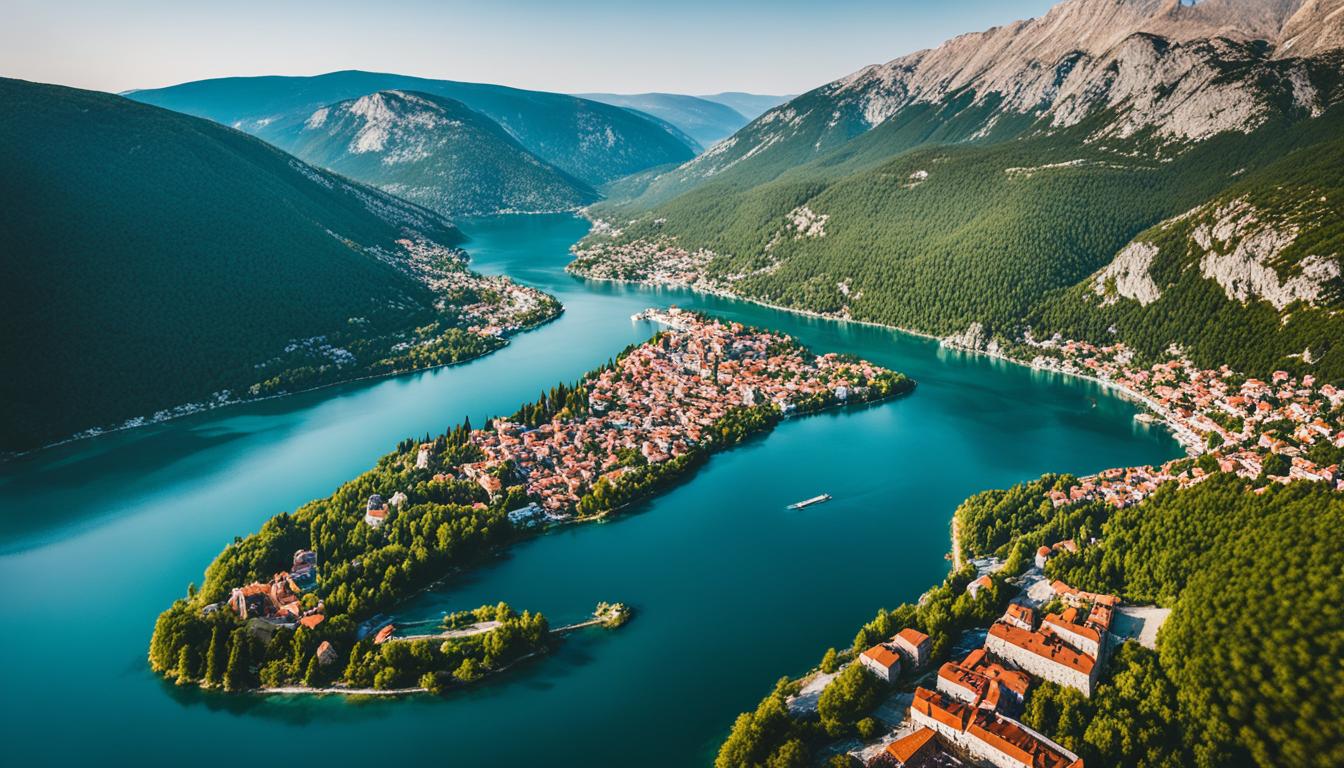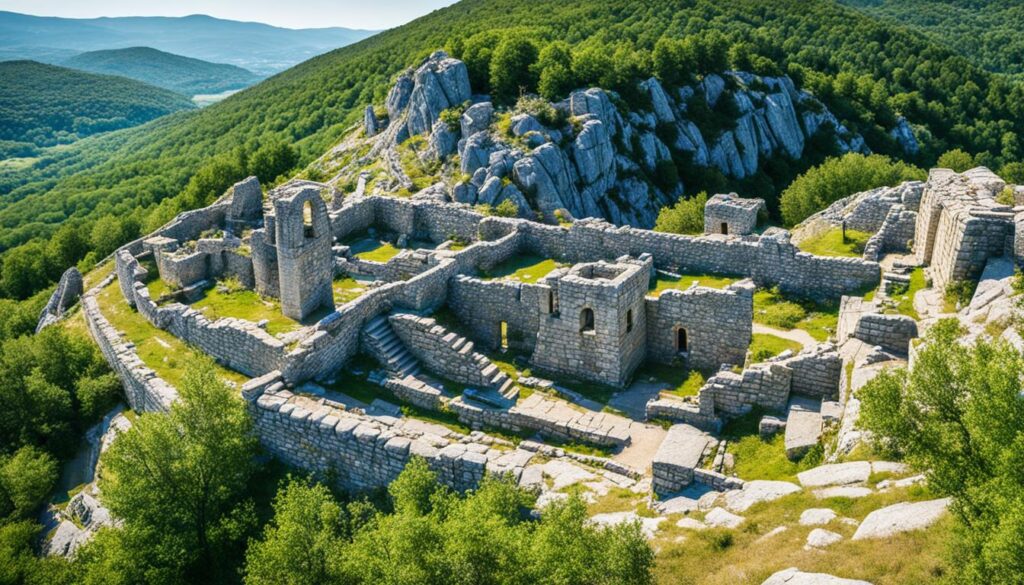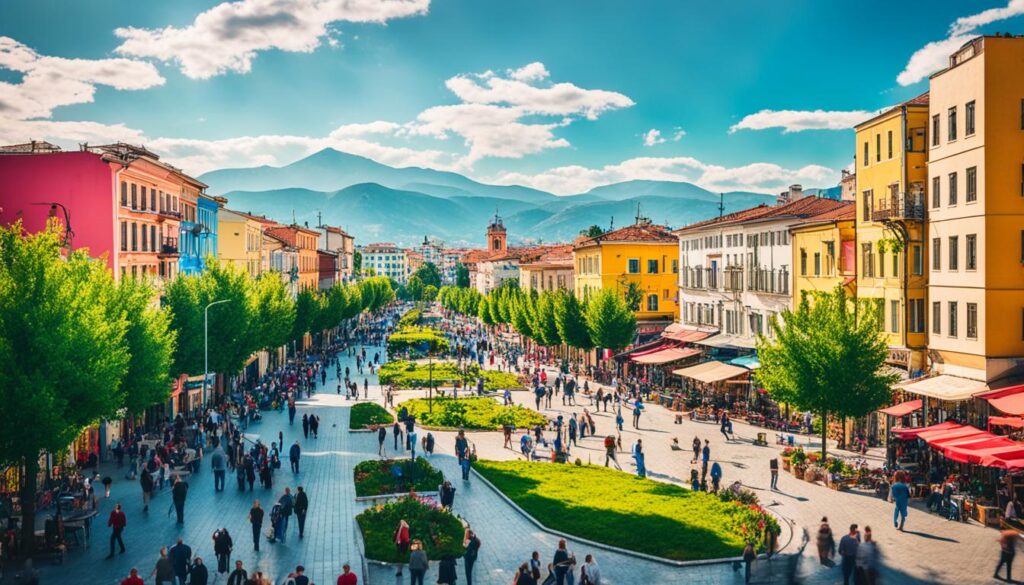
Are you looking for a unique and immersive travel experience? Look no further than Balkan Holidays, where you can uncover the hidden gems of this fascinating region. From ancient ruins and medieval fortresses to picturesque towns and breathtaking landscapes, the Balkans offer a diverse range of attractions that will captivate and inspire you.
When you think of Bulgaria, famous landmarks such as the Rila Monastery and the Alexander Nevsky Cathedral may come to mind. But did you know that Bulgaria is also home to numerous hidden gems that are waiting to be discovered? From the stunning Belogradchik Rocks to the picturesque Shipka Pass, there are plenty of hidden attractions in Bulgaria that offer a unique and memorable experience for travelers.
Key Takeaways:
- Explore the hidden gems of the Balkans and create unforgettable memories.
- Bulgaria is not just about famous landmarks, it also has hidden attractions worth discovering.
- From the Belogradchik Rocks to the Shipka Pass, Bulgaria offers diverse and breathtaking landscapes.
- Immerse yourself in the rich history and culture of the Balkans.
- Uncover the hidden gems of the Balkans and experience a truly unique travel adventure.
Belogradchik Rocks: A Natural Landmark in Bulgaria
The Belogradchik Rocks are a group of oddly shaped sandstone and conglomerate rock formations located in the Balkan Mountains of northwest Bulgaria. These rocks, with their vibrant colors and unique shapes, are a sight to behold for any nature enthusiast or adventure seeker. Some of these formations reach up to 200 meters in height, standing tall against the backdrop of the picturesque Bulgarian landscape.
Declared a Natural Landmark by the Bulgarian government, the Belogradchik Rocks are not only an awe-inspiring creation of nature but also a significant cultural symbol. They have become an emblem of Bulgaria’s hidden gems, attracting visitors from all over the world.
The Belogradchik Rocks have gained international recognition as well. They were nominated as Bulgaria’s entry in the campaign for the New 7 Wonders of Nature, a global initiative to celebrate the world’s most extraordinary natural wonders.
Shipka Pass: A Scenic Mountain Pass
The Shipka Pass is a picturesque mountain pass in Bulgaria that marks the border between the Stara Zagora province and the Gabrovo province. Situated within the Bulgarka Nature Park, this scenic route is renowned for its breathtaking beauty and historical significance.
During the Russo-Turkish War in 1877-1878, the Shipka Pass became a vital strategic location. The Bulgarian and Russian troops successfully defended the pass against the Ottoman Empire, resulting in a decisive victory. Today, the pass stands as a symbol of bravery and national pride.
The Shipka Memorial is a must-visit attraction at the pass. Built to honor the brave soldiers who fought in the Battles of Shipka Pass, this imposing monument offers a poignant tribute and a window into Bulgaria’s history. From the memorial, visitors can also enjoy panoramic views of the surrounding landscapes, including the majestic Balkan Mountains.
“The Shipka Pass is not just a scenic mountain route, but a testament to the courage and tenacity of the Bulgarian people.” – Discover Bulgaria
Whether you are a history enthusiast, nature lover, or simply seeking a peaceful escape, the Shipka Pass offers a unique experience. The combination of its stunning natural beauty, historical significance, and panoramic views make it a favorite destination for both locals and tourists.
Key Highlights:
- Scenic mountain pass in Bulgaria
- Historical significance during the Russo-Turkish War
- Home to the Shipka Memorial
- Breathtaking panoramic views of the Balkan Mountains
Next Section: Devil’s Throat Cave: A Mysterious Underground Kingdom
Devil’s Throat Cave: A Mysterious Underground Kingdom
Located in the Western Rhodopes region of Bulgaria, the Devil’s Throat Cave is a remarkable natural wonder that never fails to leave visitors in awe. This captivating underground kingdom is renowned for its unique geological features and captivating legends.
The entrance of the cave resembles the head of a devil, adding an element of mystery and intrigue to the experience. As you venture deeper into the cave, you’ll encounter the main attraction—the highest underground waterfall on the Balkan Peninsula, plunging down the cave’s throat in a breathtaking spectacle.
The Devil’s Throat Cave is shrouded in ancient legends and folklore. It is said that the cave was once the home of the mythical Orpheus, who descended into the underworld in search of his lost love, Eurydice. The roaring sound of the waterfall resembles the mournful cry of Orpheus as he mourned the loss of his beloved.
Exploring the hidden depths of the Devil’s Throat Cave is like stepping into another world. The mystical atmosphere, combined with the sound of rushing water reverberating through its ancient chambers, creates an unforgettable experience.
Discover the Mysteries Within
As you navigate through the labyrinthine passages of the Devil’s Throat Cave, you’ll be treated to stunning rock formations, stalactites, and stalagmites that have formed over thousands of years. The subterranean river that carved its way through the cave has left behind an intricate network of chambers and corridors to explore.
“Venturing into the Devil’s Throat Cave is like stepping into a hidden realm of wonder and enchantment. The thundering sound of the waterfall echoing through the caverns leaves a lasting impression on all who visit.”
Legend has it that the underground river flowing through the cave leads to an undiscovered world beneath the surface. While the exact destination remains a mystery, the allure of what lies beyond adds to the intrigue of the Devil’s Throat Cave.
Planning Your Visit
The Devil’s Throat Cave is located near the village of Trigrad in southern Bulgaria. To reach the cave, you’ll embark on a thrilling journey through scenic mountain roads, surrounded by breathtaking landscapes.
When visiting the Devil’s Throat Cave, it is advisable to wear comfortable clothing and sturdy shoes, as the terrain inside can be uneven. Guided tours are available, providing insightful commentary and ensuring a safe and informative experience.
“Don’t miss the opportunity to explore the Devil’s Throat Cave—a hidden gem in Bulgaria’s underground realm. Immerse yourself in its mystical beauty and witness nature’s masterpiece.”
| Opening Hours | Admission Fee | Guided Tours |
|---|---|---|
| 9:00 AM – 6:00 PM | $10 for adults $5 for children (under 18) |
Available daily (English-speaking guides) |
Exploring the Devil’s Throat Cave is an adventure like no other. Lose yourself in the mysteries of this hidden underground kingdom and witness the power and beauty of the highest underground waterfall in the Balkans.
Asen’s Fortress: A Medieval Stronghold
Explore the rich history of Bulgaria at Asen’s Fortress, a medieval stronghold nestled in the breathtaking Rhodope Mountains. This fortified structure, dating back to the time of the Thracians, stands as a testament to the strategic significance it held during the Roman and Byzantine periods. As a key border defense against Latin raids, Asen’s Fortress played a crucial role in Bulgarian history.
Step back in time as you wander through the well-preserved ruins of the fortress, marveling at the architectural prowess that once guarded this medieval stronghold. One of the notable highlights is the Church of the Holy Mother of God, adorned with stunning mural paintings from the 14th century. Experience the grandeur of the past and envision the lives of those who once roamed these ancient halls.
Take a moment to appreciate the panoramic views from the fortress, where the natural beauty of the Rhodope Mountains unfolds before your eyes. Immerse yourself in the tranquility of the surroundings and let the remarkable history of Asen’s Fortress captivate your imagination.
To get a glimpse of the medieval splendor, take a look at the image below:
Quick Facts
Learn more about Asen’s Fortress with these fascinating facts:
| Location | Rhodope Mountains, Bulgaria |
|---|---|
| Historical Significance | Strategic border defense against Latin raids |
| Key Features | Well-preserved ruins, Church of the Holy Mother of God |
| Architecture | Roman and Byzantine influences |
| Visiting Hours | Daily from 9:00 AM to 6:00 PM |
Embark on a journey to Asen’s Fortress and witness the grandeur of this medieval stronghold. Discover the rich history, immerse yourself in its remarkable architecture, and bask in the scenic beauty of the Rhodope Mountains.
Buzludzha Monument: An Abandoned Communist Monument
The Buzludzha Monument is a unique architectural structure located in the Central Stara Planina Mountains of Bulgaria. It was built by the Bulgarian communist regime to commemorate socialist events in the area. Although the monument is now abandoned and in a state of disrepair, it still attracts visitors with its interesting design and historical significance.
Exploring the Buzludzha Monument offers a glimpse into Bulgaria’s communist past and the opportunity to witness a piece of living history. The monument stands as a reminder of a pivotal era in Bulgarian history, capturing the spirit and aspirations of the communist regime that once ruled the country.
Visiting the Buzludzha Monument allows you to immerse yourself in the grandeur and symbolism of this abandoned communist monument. As you walk through its crumbling halls and faded murals, you can’t help but feel the weight of history and the echoes of a bygone era.
Architectural Brilliance and Unique Design
The Buzludzha Monument is renowned for its striking architectural design. Its massive concrete structure and futuristic aesthetics make it stand out amidst the mountainous landscape of Bulgaria. The monument’s grandeur and scale were meant to inspire awe and reflect the power of the communist ideology.
A Remnant of Bulgaria’s Communist Regime
During the communist era in Bulgaria, the Buzludzha Monument served as a gathering place for political rallies and events. It was a symbol of the country’s commitment to socialism and commemorated the achievements and ideals of the communist regime. Today, it stands as a testament to the complex and controversial history of Bulgaria and its journey towards democracy.
| Key Features | Information |
|---|---|
| Location | Central Stara Planina Mountains, Bulgaria |
| Architectural Style | Futuristic and Brutalist |
| Historical Significance | Communist era monument |
| Current Condition | Abandoned and in disrepair |
| Visitor Experience | Exploration of the monument’s interior and surrounding area |
The Buzludzha Monument stands as a captivating testament to Bulgaria’s communist past, attracting visitors with its unique design and historical allure. Despite its current state of abandonment, the monument continues to fascinate and intrigue those who seek to experience a piece of living history in the heart of the Bulgarian mountains.
Perperikon: An Ancient Thracian City
Perperikon is an ancient Thracian city located in the Eastern Rhodopes region of Bulgaria. It is believed to have been a sacred place and is home to the largest megalith ensemble in the Balkans. The city’s history dates back to the Bronze Age, and archaeological excavations have revealed the ruins of a multi-story palace and a fortress. Perperikon offers visitors the chance to step back in time and discover the fascinating history of the Thracian civilization.
“Perperikon is a captivating archaeological site that showcases the grandeur and complexity of the Thracian civilization. Its megalithic structures and ancient ruins provide invaluable insights into the lives and beliefs of these ancient people.” – Archaeology expert
Located on a rocky hilltop, Perperikon offers breathtaking views of the surrounding landscapes. The city was once a thriving center of trade and religious rituals, attracting pilgrims and merchants from far and wide. Today, visitors can explore the ruins of the ancient city and marvel at the ingenuity and craftsmanship of the Thracian people.
The Legends of Perperikon
Perperikon is steeped in legends and mysteries. According to one myth, the city was believed to be connected to the legendary King Midas and the Oracle of Delphi. It was said that the stone throne in Perperikon was the meeting place of the gods, where they would gather to discuss the fate of the world.
The site’s mystical allure continues to draw visitors who are intrigued by its ancient history and enigmatic aura. Exploring Perperikon is a journey of discovery, where every stone has a story to tell.

Uncovering the Secrets of Perperikon
Archaeological excavations at Perperikon have uncovered fascinating artifacts, including pottery, jewelry, and religious objects. These discoveries have shed light on the Thracian culture and its significance in the ancient world.
One of the most notable finds at Perperikon is the Temple of Dionysus, dedicated to the Greek god of wine and revelry. The temple’s ruins stand as a testament to the cultural exchange between the Thracians and the Greeks.
| Key Features | Details |
|---|---|
| Large Megalithic Structures | The site boasts impressive megalithic structures, including stone platforms, altars, and staircases. |
| Bronze Age Palace | The ruins of a multi-story palace offer a glimpse into the grandeur of ancient Thracian architecture. |
| Fortress Walls | The remains of the city’s fortress walls reveal the strategic importance of Perperikon. |
| Mysterious Tunnels | The site is crisscrossed with underground tunnels, adding to its air of mystery and intrigue. |
Visiting Perperikon is like stepping into a time portal, where the ancient world comes to life. The site’s rich history and archaeological significance make it a must-visit destination for history enthusiasts and curious travelers alike.
Budva: Montenegro’s Hidden Gem
Located along the stunning Adriatic coast of Montenegro, Budva is a hidden gem waiting to be discovered. This picturesque town is renowned for its rich history, beautiful beaches, and vibrant nightlife. Whether you’re a history enthusiast, beach lover, or partygoer, Budva offers something for everyone.
Begin your exploration of Budva by strolling through the charming streets of the Old Town. This well-preserved medieval town is dotted with ancient ruins and fortified walls, giving you a glimpse into the town’s fascinating past. Marvel at the intricate architecture of the churches and explore the narrow cobblestone alleys lined with shops, restaurants, and cafes.
For those seeking sun and relaxation, Budva boasts some of the most stunning beaches in Montenegro. From the sandy shores of Mogren Beach to the secluded hideaways of Jaz Beach, there is a beach for every preference. Take a dip in the crystal-clear waters, soak up the sun, or indulge in water sports for an unforgettable beach experience.
Budva is not just a destination for history and beach lovers; it also comes alive after dark with its vibrant nightlife. The town is famous for its energetic bars, clubs, and beach parties, attracting both locals and tourists alike. Dance the night away to the rhythms of live music, enjoy delicious cocktails, and embrace the lively atmosphere that Budva is known for.
Make sure to visit the historic Budva Citadel, located on a small peninsula overlooking the Adriatic Sea. This impressive fortress offers panoramic views of the town and surrounding coastline. Explore the ancient walls, visit the museum inside the fortress, and capture breathtaking photos to treasure.
“Budva is a hidden gem of the Balkans, offering a unique blend of cultural heritage, natural beauty, and vibrant nightlife.”
Escape the crowds in Budva by venturing out to the nearby island of Sveti Stefan. This exclusive islet is home to a luxurious resort and offers a secluded and idyllic retreat. Enjoy a day of relaxation on the private beach, indulge in spa treatments, or savor delicious seafood delicacies.
In conclusion, Budva is a treasure trove of history, natural beauty, and nightlife, making it a hidden gem in Montenegro. Embrace the charm of the Old Town, soak up the sun on the beautiful beaches, and immerse yourself in the vibrant nightlife. Budva is the perfect destination for those seeking a diverse and unforgettable experience in the Balkans.
Prizren: Discovering the Beauty of Kosovo
Prizren is a picturesque town in Kosovo that offers a glimpse into the country’s rich history and cultural heritage. Nestled amidst beautiful landscapes, Prizren is a hidden gem in the Balkans that is waiting to be explored. This charming town is known for its well-preserved historic streets, lined with traditional houses that showcase the architectural beauty of the region.
A highlight of Prizren is the stunning Sinan Pasha Mosque, a symbol of the town’s Ottoman influence. Its elegant design and intricate details make it a must-visit attraction for history enthusiasts and architecture lovers. The mosque stands as a testament to the cultural diversity and religious heritage of Prizren.
For stunning panoramic views, a hike up to the Prizren Fortress is a must. Perched on a hilltop overlooking the town, the fortress offers breathtaking vistas of the surrounding landscapes. Explore the ancient walls, towers, and courtyards while immersing yourself in the rich history of the region.
Prizren is not just a town filled with historical gems, but it is also a vibrant cultural hub. The town hosts various festivals and events throughout the year, showcasing Kosovo’s traditional music, dance, and culinary delights. Visitors can experience the warm hospitality of the locals and indulge in delicious traditional dishes.
Prizren’s charm lies in its authenticity and the preservation of its cultural heritage.
Take a leisurely stroll through the historic Shadervan Square and soak in the atmosphere of this bustling meeting point. Cafes, shops, and artisans selling handmade crafts line the streets, offering visitors a chance to take a piece of Prizren’s artistic spirit home with them.
| Attractions | Description |
|---|---|
| Sinan Pasha Mosque | A stunning Ottoman mosque that showcases the town’s rich cultural heritage. |
| Prizren Fortress | A hilltop fortress with breathtaking views of Prizren and its surrounding landscapes. |
| Shadervan Square | A vibrant square filled with cafes, shops, and artisans, offering a taste of local culture. |
Discover the hidden gem of Prizren and immerse yourself in its captivating beauty, cultural heritage, and warm hospitality. Whether you’re exploring the historic streets, admiring the architecture, or indulging in the local cuisine, Prizren offers an authentic and unforgettable experience in the heart of Kosovo.
Tirana: Albania’s Vibrant Capital
Tirana is the dynamic capital of Albania, known for its unique blend of Ottoman, Italian, and Communist architecture. Explore the bustling streets, visit the Skanderbeg Square, and discover the vibrant cultural scene. Tirana offers a taste of authentic Albanian lifestyle and a chance to immerse yourself in the country’s rich history and vibrant atmosphere.
Discover Tirana’s architecture:
Ottoman Architecture
Tirana showcases several Ottoman architectural gems, reflecting the city’s historical influences. The Et’hem Bey Mosque, built in the 18th century, is a standout example of Ottoman Islamic architecture. With its beautifully crafted interiors and unique frescoes, it is a must-visit for architecture enthusiasts and history buffs alike.
Italian Architecture
Italian influence can be seen in Tirana’s numerous buildings and facades. The grand Palace of Culture stands as a testament to this architectural style, with its beautiful neoclassical design. The building is home to the National Theatre of Opera and Ballet, offering visitors the opportunity to experience Albania’s rich artistic heritage.
Communist Architecture
Tirana also showcases a significant number of buildings from the Communist era, characterized by their bold and imposing designs. The Pyramid of Tirana, once a museum dedicated to the country’s communist leader Enver Hoxha, now stands as a controversial monument. While its future remains uncertain, it serves as a powerful reminder of Albania’s complex past.

Table: Architectural Influences in Tirana
| Ottoman Architecture | Italian Architecture | Communist Architecture |
|---|---|---|
| Eth’hem Bey Mosque | Palace of Culture | Pyramid of Tirana |
| 18th-century mosque with unique frescoes | Neoclassical design, home to the National Theatre of Opera and Ballet | Controversial monument from the communist era |
Experience the vibrant culture of Tirana:
“Tirana is a city where history, art, and innovation converge. Its streets are a living canvas, adorned with colorful murals that tell stories of the city’s past and present. The National Gallery of Art showcases the works of Albanian artists, providing a deeper insight into the country’s artistic heritage. In addition, the vibrant bar and cafe scene in Blloku district offers a taste of Tirana’s lively nightlife and contemporary culture.”
Don’t miss Skanderbeg Square, the city’s bustling central plaza named after the national hero George Kastrioti Skanderbeg. Here you’ll find landmarks such as the National History Museum, the Opera House, and the Clock Tower, all contributing to the vibrant atmosphere of Tirana.
With its rich blend of history, architecture, and culture, Tirana is a vibrant capital that offers a unique and immersive experience for travelers exploring Albania.
Lake Ohrid: Macedonia’s Hidden Gem
Located in Macedonia, Lake Ohrid is a true hidden gem in the Balkans. This UNESCO World Heritage Site is known for its crystal-clear waters, breathtaking scenery, and rich historical significance.
One of the main attractions of Lake Ohrid is the charming town of Ohrid that sits on its shores. Visitors can explore the narrow cobblestone streets, admire the traditional architecture, and immerse themselves in the local culture and hospitality.
A visit to Lake Ohrid wouldn’t be complete without experiencing its impressive collection of medieval churches. These architectural wonders are adorned with stunning frescoes that tell stories from centuries ago. The intricate artwork and vibrant colors are truly captivating, offering a glimpse into Macedonia’s rich cultural heritage.
Another way to appreciate the beauty of Lake Ohrid is by taking a boat trip on its tranquil waters. Whether it’s a leisurely cruise or an adventurous kayaking excursion, exploring the lake allows you to embrace the serene atmosphere and take in the picturesque surroundings.
Lake Ohrid is an ideal destination for those seeking a peaceful and idyllic escape. With its pristine waters, charming villages, and fascinating history, it offers a unique experience that is sure to leave a lasting impression.
Explore Lake Ohrid: Top attractions and activities
| Attraction | Description |
|---|---|
| Ohrid Old Town | Discover the rich history and culture of the town through its narrow streets, ancient theaters, and archaeological sites. |
| Saint Naum Monastery | Visit this beautiful monastery located on the southern shores of Lake Ohrid and enjoy panoramic views of the lake and surrounding mountains. |
| Plaošnik | Explore the archaeological site of Plaošnik, which features the Church of St. Clement and the ruins of an early Christian basilica. |
| Galičica National Park | Embark on a hiking adventure in this national park, which offers stunning vistas of Lake Ohrid and the surrounding mountains. |
Whether you’re interested in history, nature, or simply looking for a peaceful retreat, Lake Ohrid is the ultimate hidden gem in Macedonia. Plan your visit and embark on an unforgettable journey to this breathtaking destination.
Meteora: A Spiritual Oasis in Greece
The magnificent Meteora is a UNESCO World Heritage Site nestled in the heart of Greece. This awe-inspiring destination is renowned for its towering rock formations that seem to defy gravity, creating a truly mesmerizing sight. Perched atop these towering cliffs are six majestic monasteries, each offering a glimpse into the rich spiritual heritage of the region.
As you explore Meteora, you’ll be captivated by the breathtaking views that stretch as far as the eye can see. The combination of the dramatic landscape and the peaceful ambiance creates a sense of tranquility and serenity, making Meteora a true spiritual oasis.
“Meteora is a place where you can feel the presence of something greater than yourself. It’s a sanctuary for the soul, where the divine and the earthly merge in perfect harmony.” – Travel enthusiast
Visiting the monasteries of Meteora offers a unique opportunity to embark on a spiritual journey. Step inside these ancient sanctuaries, adorned with stunning frescoes and filled with a sense of sacredness that has transcended the passage of time.
Embrace the Spiritual Essence of Meteora
Take time to explore each monastery and immerse yourself in the spiritual essence of Meteora. Marvel at the exquisite architecture, walk in the footsteps of monks, and witness the beauty of the intricate artwork that tells stories of devotion and faith. As you stand on the precipice of one of the cliffs, the world seems to melt away, allowing you to connect with something greater than yourself.
Whether you choose to visit the Monastery of Great Meteoron, St. Stephen’s Monastery, or any of the other monastic sites, each offers a unique experience and a deeper understanding of the spiritual traditions that have thrived here for centuries.
Immerse Yourself in the Tranquility of Meteora
Aside from the monasteries, Meteora’s natural beauty provides an opportunity for serene contemplation and reflection. Take a stroll along the well-marked trails that wind through the rocky landscape, breathing in the crisp mountain air and allowing the stillness to envelop you.
- Pause at one of the many viewing platforms and witness the breathtaking vistas that stretch across the valley below.
- Listen to the gentle whispers of the wind as it dances through the ancient rocks.
- Find a quiet spot to meditate and let the peace of Meteora seep into your soul.
Whether you’re seeking solace, renewal, or simply a moment of inner silence, the spiritual essence of Meteora will embrace you, leaving an indelible mark on your journey.
| Experience | Highlights |
|---|---|
| Visit the Monasteries | Marvel at the stunning architecture and intricate frescoes. Feel the sacred energy that permeates each site. |
| Hike the Trails | Explore the serene beauty of the natural landscapes, immersing yourself in the tranquility of Meteora. |
| Experience a Sunset | Witness the dramatic colors of the sunset as they illuminate the towering cliffs, creating a truly magical atmosphere. |
| Photography | Capture the breathtaking landscapes and the spiritual essence of Meteora through the lens of your camera. |
With its ethereal beauty and profound sense of spirituality, Meteora is a destination unlike any other. Allow yourself to be immersed in its enchanting allure and discover the transformative power of this spiritual oasis in Greece.
Thessaloniki: Greece’s Vibrant Second City
Located in the heart of Greece, Thessaloniki is a vibrant and bustling city that offers a unique blend of history, culture, and gastronomy. As Greece’s second largest city, Thessaloniki is often overshadowed by Athens, but it holds its own as a must-visit destination in the Balkans.
Thessaloniki is steeped in rich history, with a heritage that dates back over 2,300 years. The city was founded in 315 BC by King Cassander of Macedon and named after his wife, Thessalonike, who was the half-sister of Alexander the Great. Throughout its long and storied past, Thessaloniki has been influenced by various civilizations, including the Romans, Byzantines, Ottomans, and Jews, each leaving their mark on the city’s architecture, traditions, and cuisine.
One of the highlights of Thessaloniki is its wealth of archaeological sites that showcase its ancient past. The Rotunda, a circular building originally built as a Roman mausoleum, later converted into a church and then a mosque, is a testament to the city’s diverse history. The Arch of Galerius, also known as Kamara, is an imposing monument that commemorates the victory of Emperor Galerius over the Persians. These sites offer a glimpse into the city’s past and allow visitors to immerse themselves in its rich historical heritage.
Thessaloniki is also home to numerous museums that highlight its cultural significance. The Museum of Byzantine Culture showcases the city’s Byzantine legacy, with an impressive collection of art and artifacts from this influential period. The Archaeological Museum of Thessaloniki houses a vast collection of artifacts, including ancient statues, ceramics, and jewelry, providing a comprehensive overview of the region’s ancient history. These museums offer a deeper understanding of Thessaloniki’s cultural heritage and serve as a source of inspiration for art enthusiasts and history buffs alike.
The Gastronomic Delights of Thessaloniki
No visit to Thessaloniki is complete without indulging in its renowned cuisine. The city is known for its vibrant food scene, with a wide range of traditional dishes that reflect its multicultural heritage. Be sure to try the famous mpougatsa, a mouthwatering pastry filled with creamy custard or cheese, and the iconic souvlaki, a delectable skewer of grilled meat served with pita bread and tzatziki sauce. Thessaloniki is also famous for its fresh seafood, with the ladotyri (olive oil cheese) and tsipouro (anise-flavored liquor) being local specialties that should not be missed.
“Thessaloniki offers a mix of ancient history and modern allure, making it a must-visit destination in the Balkans.”
Thessaloniki’s vibrant second city atmosphere is enhanced by its lively nightlife and thriving arts scene. The city is home to numerous bars, clubs, and music venues that offer a variety of entertainment options. Additionally, Thessaloniki hosts several cultural events and festivals throughout the year, including the Thessaloniki International Film Festival and the Dimitria Festival, showcasing the city’s commitment to the arts.
In conclusion, Thessaloniki is a vibrant and culturally-rich city that offers visitors a unique blend of ancient history, modern allure, and gastronomic delights. Whether you’re exploring archaeological sites, visiting museums, or indulging in the local cuisine, Thessaloniki promises an unforgettable experience that encapsulates the essence of Greece’s vibrant second city.
Mount Olympus: The Realm of Greek Mythology
Mount Olympus, known as the home of the gods in Greek mythology, is a legendary mountain located in Greece. Its towering peaks and rugged landscapes have captivated the imaginations of people for centuries.
To truly experience the mystical aura of Mount Olympus, visitors can embark on a thrilling hike through its majestic trails. As you ascend, you’ll immerse yourself in the awe-inspiring beauty of the surroundings and feel a sense of connection with the ancient myths that unfolded on this sacred mountain.
For history enthusiasts, a visit to the nearby archaeological site of Dion is a must. This ancient city was a center of worship and played a significant role in religious ceremonies held in honor of the gods. Explore the ruins and discover the remnants of a glorious past that once thrived in this sacred place.
As you traverse the rugged terrain of Mount Olympus, you’ll be enveloped by the captivating stories of Greek mythology. Imagine Zeus, Athena, and the other gods residing in their celestial realm, watching over the mortal world below. Let your imagination transport you to a time when gods and mortals coexisted, their destinies intertwined amidst the mysteries of Mount Olympus.
“Mount Olympus, the abode of the gods, resonates with the echoes of ancient legends. Its majesty and aura make it a sacred place, a realm where mythology comes to life.”
Mount Olympus offers a unique and mystical experience for those seeking a deeper connection to Greek culture and history. It invites you to step into the realm of myth, where gods and heroes once roamed, and where the stories of ancient Greece continue to inspire and enchant.
| Experience | Highlight |
|---|---|
| Hiking | Traverse the rugged landscapes and immerse yourself in the natural beauty of Mount Olympus. |
| Archaeological site | Visit the nearby ancient city of Dion and explore its well-preserved ruins. |
| Mythological connection | Feel the presence of Greek mythology as you explore the mystical realms of Mount Olympus. |
Discover the allure of Mount Olympus and let the myths of ancient Greece guide your journey through this sacred mountain.
Conclusion
Embark on a remarkable journey with Balkan holidays and uncover the hidden gems that lie within the enchanting Balkan region. From ancient ruins that whisper tales of past civilizations to medieval fortresses that stand as silent witnesses to history, the Balkans offer a treasure trove of discoveries for every traveler.
Immerse yourself in the rich tapestry of culture as you explore picturesque towns, stroll through cobblestone streets, and encounter the warmth and hospitality of the locals. The Balkans captivate with their breathtaking landscapes, from majestic mountains to crystal-clear lakes, providing a haven for nature lovers and adventure seekers alike.
Whether you’re drawn to the allure of history, the enchantment of folklore, or the splendor of the untouched wilderness, the Balkans beckon you to discover their hidden gems. Uncover the secrets of this mesmerizing region and create cherished memories that will last a lifetime. Balkan holidays are a gateway to a world waiting to be explored, where the wonders of the past mingle with the allure of the present. Don’t miss the opportunity to experience the magic of the Balkans.







